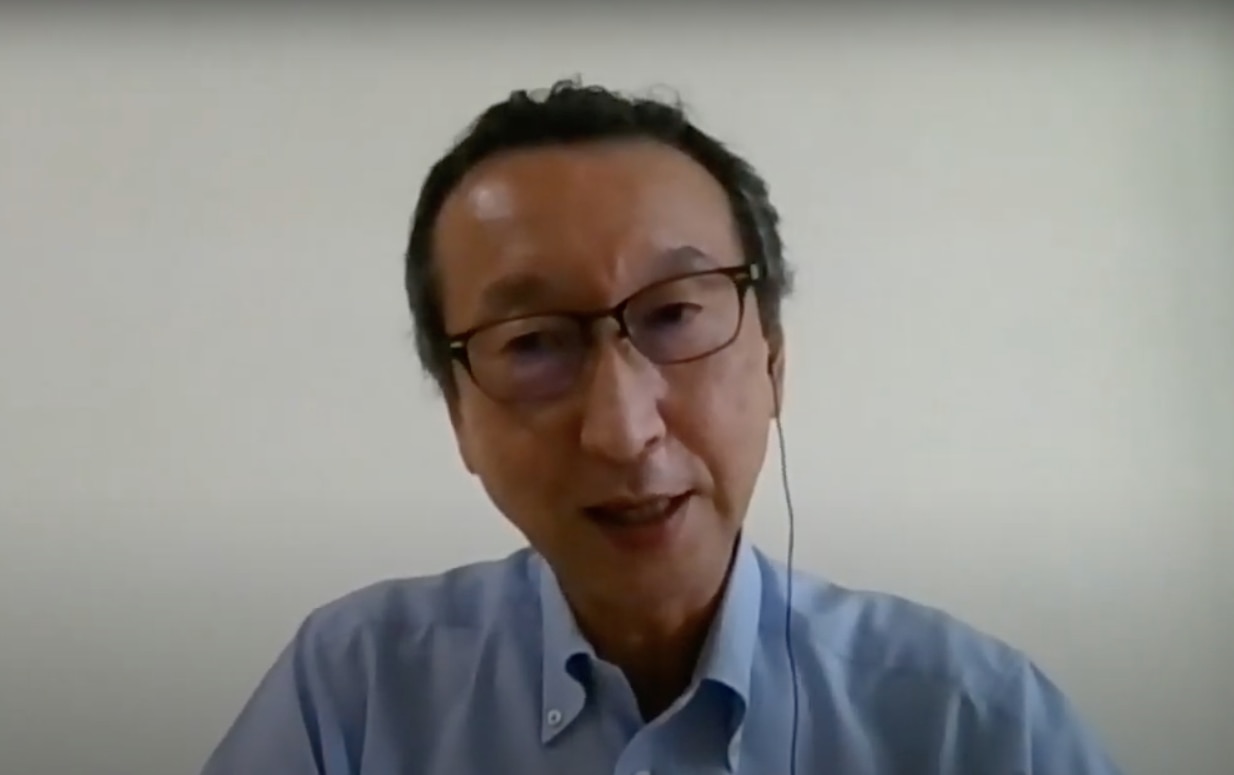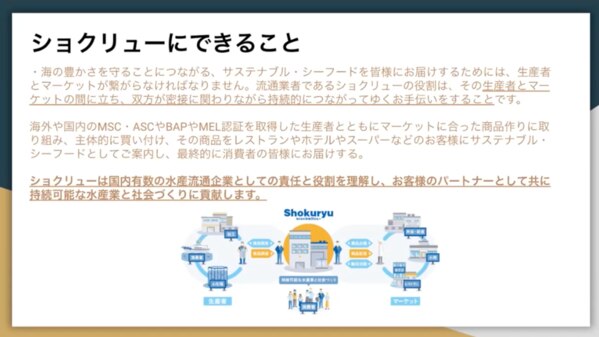
How to Leverage SDGs Goal 14 on Business? – Seminar Report 2
Webinar Series “SDGs Goal 14 Startup Seminar: What Seafood Companies Can Do for Not to Fall behind the Time”
Session 2: "How Can Seafood Companies
Utilize Compliance Activities and Incorporate Them into Business Operations?"
Organizer: Seafood Legacy Co., Ltd.
Facilitator: Ryo Takahashi, Business Engagement Officer, Seafood Legacy Co., Ltd.
This webinar is a four-part course to learn practical ways to make the seafood industry sustainable together with companies’ businesses.
It will provide useful information for companies in the seafood industry as well as companies outside the seafood industry that are considering introducing sustainable seafood, for instance, to their company cafeterias.
Through this seminar, we share what is happening around seafood sustainability, the benefits of introducing sustainable seafood, and the business continuity risks of not introducing them, as well as specific methods and ideas for integrating sustainable seafood into existing and new businesses.
This report is a brief introduction to the second session.
For more information about the first session, please read here.
Making People Happy with Seafood: A Distribution Company's Approach to Bringing the Sustainable Future
Presented by Mr. Fumiyuki Shoji, Business Planning Department, Shokuryu Co., Ltd.
<Key Takeaways>
・The role of distribution companies is to stand between producers and markets and to help both parties to work closely and sustainably together
・When consumers buy certified products or order a certified menu, they should know that they are directly involved in issues such as IUU (illegal, unreported, and unregulated) fishing and the depleting fishery resources
・We need to think about and share with our customers the potential risks of dealing with non-certified products
At the beginning of the presentation, he talked about the business model of Shokuryu. Shokuryu has four branches and regional sales offices across Japan, forming a broad network. By taking advantage of this network, they are able to offer a wide variety of products while staying close to locals and are able to propose products and delivery forms that meet the needs of their customers.
Mr. Shoji pointed out the following three things that Shokuryu can do:
- Stand between producers and markets, and help both parties to work closely and sustainably together
- Work with certified producers in Japan and abroad to create products that meet the needs of the - market, proactively purchase products, and deliver sustainable seafood to consumers
- Understand the company’s responsibilities and roles as one of Japan's leading seafood distribution companies, and contribute to the creation of sustainable seafood industry and society together with our customers

©︎ Shokuryu Co., Ltd.
Based on the above, a panel discussion was held in the latter half of the session.
Panel discussion (excerpt)
Q: You mentioned that you would acquire 100% MSC/ASC certification at all your locations by March 2022, what was the background to this goal?
A: Initially, we adopted this target in order to expand our own business in anticipation of expanding the market for certified products, but in light of the fact that demand for certified products grew significantly after the London 2012 Summer Olympics, we thought it is necessary to move ahead of other companies and anticipate the expansion of the market after the Tokyo 2020 Summer Olympics.
Q: What challenges did you face in promoting activities, such as the management of CoC certification within the company? How did you solve them?
A: In the beginning, the company as a whole had a low awareness of sustainable seafood, and there was not much recognition of the issues within the company. Considering the cost and effort to introducing it, we first created a variety of opportunities to gain the understanding of management.
The biggest issue was the increased workload of inventory management, voucher management, and other on-site tasks. Some people within the company said that it would be better not to do this because it would be costly and time-consuming, so it was necessary to reduce the workload while gaining the understanding of the front-line workers for the new approach. The former was solved by holding training sessions at each site and discussing with each person in charge the significance of contributing to the realization of a sustainable society for the future through their work, while the latter was solved by improving the system and operation methods at the sites.
Q: The introduction of sustainable seafood may seem like a high hurdle, but what specific actions did your company take as the first step toward introducing it?
A: When we were considering the introduction of sustainable seafood, we were in the midst of renewing our website, so we created a page about sustainability in cooperation with Seafood Legacy. By being involved in the creation of the page, we were able to deepen our knowledge and use it in subsequent recruitment and sales activities.
Q: Were the study sessions held mainly by the sales department?
A: The person in charge of planning went around to all the sales offices in Japan and held the training sessions. The time of day was chosen in consideration of the sales staff's work schedule, and we created an atmosphere in which everyone could easily participate.
Q: What is your strategy for promoting sustainable seafood?
A: When appealing to consumers, simply stirring up a sense of crisis may not be effective. Therefore, I think it is important to present the positive benefits that can be given to society.
In the latter half of the discussion, there were talks about how to interact with stakeholders and what the companies should do under the COVID-19 pandemic.
In the discussion, Mr. Shoji said, "When purchasing certified products or ordering a certified menu, I would like consumers to know that they are directly involved in issues such as IUU fishing and depleting fishery resources, and conversely, the risks that may increase by handling non-certified products. Certified products are just a tool, but we would like to share awareness with our valued customers and expand opportunities to think about a sustainable future."
In this session, he introduced the business model of Shokuryu Co. Ltd., and talked about the difficulties they faced in introducing sustainable seafood and the actions they took within the company so that we could learn about advanced examples of seafood companies.
We learned once again the importance of attaching significance to our sustainable activities by looking at the role that seafood distribution companies should play and how they should face the challenge of contributing to the realization of a sustainable society.
In the previous session, we introduced the benefits of companies choosing sustainable seafood and the risks of not choosing it, but as mentioned in this session, it is becoming more and more important to share the awareness of the issues with consumers and have them understand the positive impact that choosing sustainable seafood can have on society.
<<< Read the report of Session 1
>>> Read the report of Session 3
Original Japanese text by : Ryo Takagi





